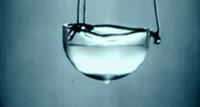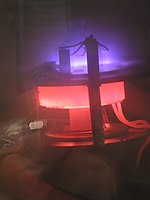
Exactly solvable single-trace four point correlators in χCFT4
Sign Up to like & getrecommendations! Published in 2021 at "Journal of High Energy Physics"
DOI: 10.1007/jhep02(2021)146
Abstract: In this paper we study a wide class of planar single-trace four point correlators in the chiral conformal field theory (χCFT4) arising as a double scaling limit of the γ-deformed $$ \mathcal{N} $$ = 4… read more here.
Keywords: trace four; point correlators; single trace; exactly solvable ... See more keywords

An exactly solvable model of polymerization
Sign Up to like & getrecommendations! Published in 2017 at "Chemical Physics"
DOI: 10.1016/j.chemphys.2017.06.016
Abstract: Abstract This paper considers the evolution of a polydisperse polymerizing system comprising g 1 , g 2 … – mers carrying ϕ 1 , ϕ 2 … functional groups reacting with one another and binding… read more here.
Keywords: polymerization; mass; model polymerization; solvable model ... See more keywords

Spin-wave oscillations in gradient ferromagnets: Exactly solvable models
Sign Up to like & getrecommendations! Published in 2020 at "Journal of Magnetism and Magnetic Materials"
DOI: 10.1016/j.jmmm.2020.166643
Abstract: Abstract The method of searching for the profiles of the gradient dependence of the material parameters of matter on the coordinates that allow the exact solution of wave equations, developed previously for electromagnetic and elastic… read more here.
Keywords: spin wave; wave oscillations; gradient ferromagnets; ferromagnets exactly ... See more keywords

An exactly solvable ansatz for statistical mechanics models
Sign Up to like & getrecommendations! Published in 2021 at "Journal of Statistical Mechanics: Theory and Experiment"
DOI: 10.1088/1742-5468/ac0152
Abstract: We propose a family of ‘exactly solvable’ probability distributions to approximate partition functions of two-dimensional statistical mechanics models. While these distributions lie strictly outside the mean-field framework, their free energies can be computed in a… read more here.
Keywords: mechanics models; statistical mechanics; ansatz statistical; exactly solvable ... See more keywords

Rule 54: exactly solvable model of nonequilibrium statistical mechanics
Sign Up to like & getrecommendations! Published in 2021 at "Journal of Statistical Mechanics: Theory and Experiment"
DOI: 10.1088/1742-5468/ac096b
Abstract: We review recent results on an exactly solvable model of nonequilibrium statistical mechanics, specifically the classical rule 54 reversible cellular automaton and some of its quantum extensions. We discuss the exact microscopic description of nonequilibrium… read more here.
Keywords: model nonequilibrium; statistical mechanics; nonequilibrium statistical; solvable model ... See more keywords

Exactly solvable model of Fermi arcs and pseudogap
Sign Up to like & getrecommendations! Published in 2021 at "Physical Review B"
DOI: 10.1103/physrevb.103.024529
Abstract: We introduce a very simple and exactly solvable model that supports Fermi arcs in its ground state and excitation spectrum. These arcs come in pairs, and merge into what we call a pseudo-Fermi surface along… read more here.
Keywords: solvable model; fermi arcs; pseudogap; exactly solvable ... See more keywords

Exactly solvable vacuum decays with gravity
Sign Up to like & getrecommendations! Published in 2021 at "Physical Review D"
DOI: 10.1103/physrevd.104.065007
Abstract: Using a new approach to the analysis of false vacuum decay based on the so-called tunneling potential, we develop a general method to find scalar potentials with a false vacuum with exactly solvable decay at… read more here.
Keywords: vacuum decays; vacuum; exactly solvable; solvable vacuum ... See more keywords

Exactly Solvable Quantum Impurity Model with Inverse-Square Interactions.
Sign Up to like & getrecommendations! Published in 2019 at "Physical review letters"
DOI: 10.1103/physrevlett.123.066406
Abstract: We construct an exactly solvable quantum impurity model which consists of spin-1/2 conduction fermions and a spin-1/2 magnetic moment. The ground state is a Gutzwiller projected Fermi sea with nonorthonormal modes and its wave function… read more here.
Keywords: quantum impurity; solvable quantum; inverse square; exactly solvable ... See more keywords

Exactly Solvable Magnet of Conformal Spins in Four Dimensions.
Sign Up to like & getrecommendations! Published in 2020 at "Physical review letters"
DOI: 10.1103/physrevlett.125.031603
Abstract: We provide the eigenfunctions for a quantum chain of N conformal spins with nearest-neighbor interaction and open boundary conditions in the irreducible representation of SO(1,5) of scaling dimension Δ=2-iλ and spin numbers ℓ=ℓ[over ˙]=0. The… read more here.
Keywords: conformal spins; exactly solvable; conformal; spins four ... See more keywords

Development of an Exactly Solvable Model of Resonance Tunneling of Electromagnetic Waves through Gradient Barriers in a Nonuniform Magnetoactive Plasma
Sign Up to like & getrecommendations! Published in 2018 at "Plasma Physics Reports"
DOI: 10.1134/s1063780x18100033
Abstract: An exactly solvable one-dimensional model describing resonance tunneling (reflectionless transmission) of a transverse electromagnetic wave through wide layers of magnetoactive plasma is developed on the basis of the Helmholtz equation. The plasma layers include a… read more here.
Keywords: plasma; magnetoactive plasma; resonance tunneling; model ... See more keywords

Exactly Solvable Model Problem on a Graphene Nanoribbon with Zigzag Edges
Sign Up to like & getrecommendations! Published in 2020 at "Semiconductors"
DOI: 10.1134/s1063782620020074
Abstract: Abstract Exact analytical expressions for the local densities of states and the occupation numbers of atoms at the zigzag edge of a graphene nanoribbon are derived in the context of a simple structural model. As… read more here.
Keywords: graphene nanoribbon; graphene; model; exactly solvable ... See more keywords